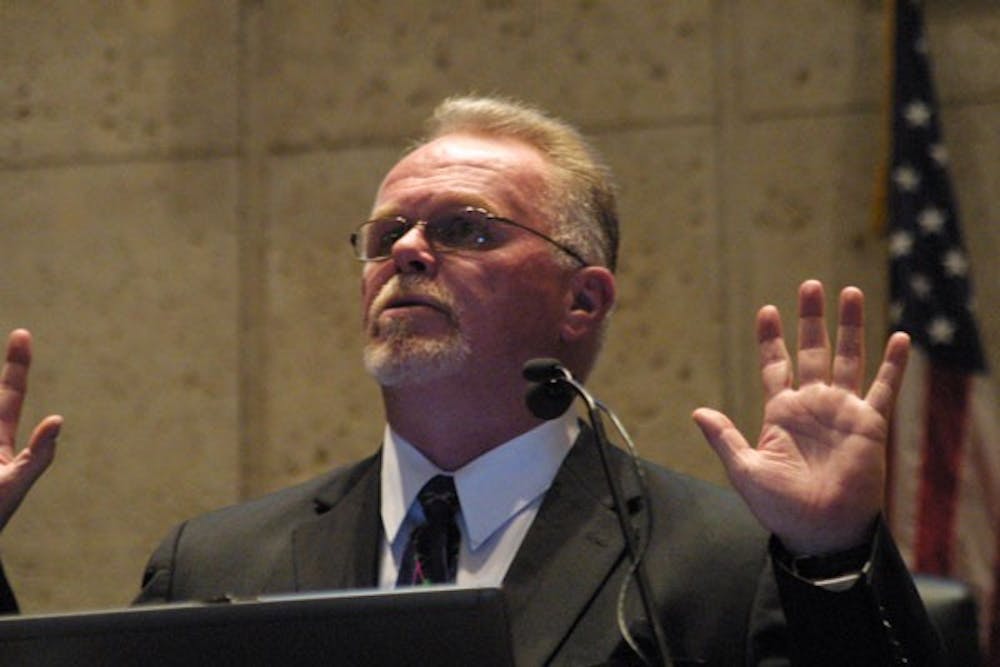On March 8, 1985, Kirk Bloodsworth was sentenced to death for the murder of a 9-year-old girl in Baltimore County, Md.
On Thursday, Bloodsworth was at Armstrong Hall in Tempe, telling students how he became the first person sentenced to death row to be exonerated by DNA evidence.
Bloodsworth spent eight years, 11 months and nine days in the Maryland Penitentiary, and now lobbies on behalf of the Arizona Justice Project, an organization dedicated to helping overturn wrongful convictions in Arizona.
“I’ve told this story for 16 years from Japan to London,” Bloodsworth said. “It’s a story I wish I didn’t have to tell you.”
Bloodsworth said his photo was chosen out of a group of suspects by a pair of boys, ages 8 and 10, who witnessed the victim with a man shortly before her death. Later, in a criminal lineup, he said the same boys chose a police officer standing two people down from Bloodsworth as the suspect.
A criminal profile, completed after Bloodsworth’s arrest, was used against him in his trial and eventually aided in his conviction, he said.
In the early 1990s, after learning about the first conviction using DNA evidence, Bloodsworth said he figured DNA evidence could also be used to free the wrongly convicted.
When he wrote a letter to the prosecutor seeking the DNA evidence from the case, she informed Bloodsworth the evidence was “inadvertently destroyed.”
A clerk of the court eventually found the evidence in a brown paper bag in the closet of the judge’s chambers, Bloodsworth said, and his lawyer began an effort to have the DNA compared.
Bloodsworth’s lawyer paid a $15,000 fee for the testing out-of-pocket, and after one year, the testing revealed that he did not kill the young girl.
In 1993 Bloodsworth was released from prison, and he began lobbying for DNA testing of innocence claims across the country.
Carrie Sperling, the executive director of the Arizona Justice Project, said Bloodsworth’s efforts have helped pass legislation to set aside funding for DNA testing in cases of innocence claims.
“Our goal is to make pretty darn certain there aren’t any Kirk Bloodsworths in prisons in Arizona,” Sperling said.
Even after his release, Bloodsworth said he faced animosity from those around him. He received harassing phone calls from people for 10 years after his release, and all the money granted to him by the state of Maryland was instantly used to repay lawyer and court fees, Bloodsworth said.
In 2003, the DNA evidence from the case was matched to a man named Kimberly Shay Ruffner, who had been arrested a month after Bloodsworth in 1984 for different sexual assault crimes. Bloodsworth said Ruffner had been living for nearly 10 years in the Maryland Penitentiary, just one floor below him.
DNA testing has led to the exoneration of more than 200 people in the United States, Bloodsworth said, but 16 years later, he is still helping to get other wrongly convicted individuals exonerated.
In 2004, Congress passed the Innocence Protection Act, which included the Kirk Bloodsworth Post-Conviction DNA Testing Program. The program gave $25 million to states to help pay for post-conviction DNA testing.
“I can’t even imagine what it was like for him; it’s like something you see in the movies,” political science senior Christoph Weber said. “He was put away for almost a decade, but making sure we have these new types of technology can provide hope.”
Reach the reporter at mhendley@asu.edu





